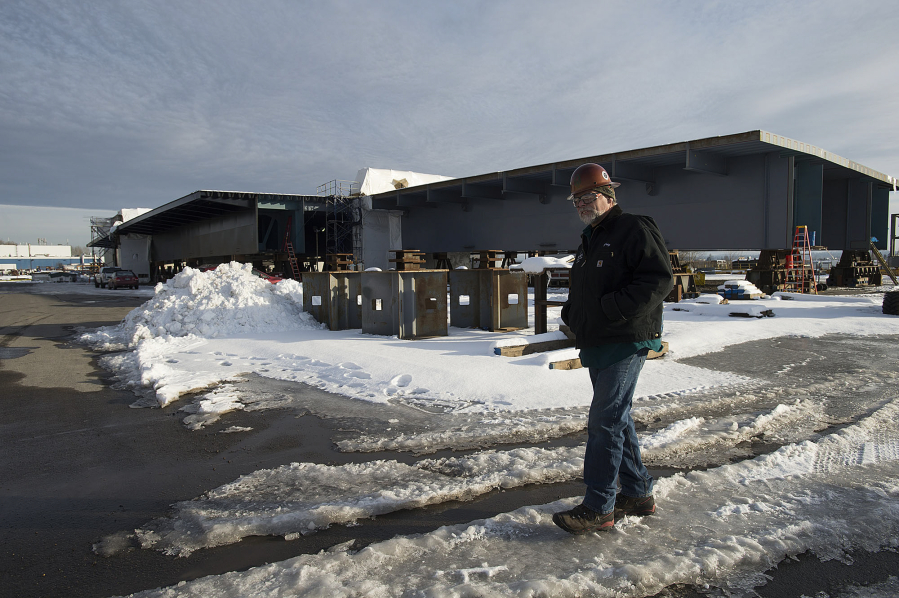On a mid-January afternoon, most of the pieces of the Wittpenn Bridge deck were fitted together near the Columbia River. Set on pilings, the deck rose in the air, caked in snow and ice while a dozen workers clambered around and underneath.
“They were out here when it was nine degrees on Friday,” said Greg Arnold, the 56-year-old plant manager. “We’re so used to being in it that we don’t look at (the weather forecast) in the morning.”
For the past two years, workers at Vigor Industrial in Vancouver quietly assembled the massive bridge deck at a warehouse at the Columbia Business Center. About 400 workers have had a hand in its making. This spring the deck will be broken into three pieces, then barged through the Panama Canal on the way to New Jersey.
It is one of the biggest items manufactured in Vancouver and the Portland area in recent years. Though the company wouldn’t disclose the contract’s worth, the bridge is a 3 million pound prize in a feast or famine industry.
“If you wanted to look down at the numbers, it’s something like 120,000 man hours of work,” said Tom Hickman, a company executive.
The United States lost 5.7 million manufacturing jobs from 2000 to 2010, according to the Wall Street Journal. Jobs have ticked up in recent years, but still fall short of the pre-recession levels and its peak in the 1970s.
In that same time period, Clark County shed about one-third of its own manufacturing workers. Other sectors like retail and business services have rebounded. Leisure and hospitality recently overtook manufacturing in terms of employment.
But manufacturing remains a cherished line of work in America and to many in Clark County. The average manufacturing job here still pays $55,951, while the county average remains at $47,420. And some companies in the industrial park say they are optimistic about the years ahead.
Bridge to somewhere
For months, workers hammered and welded, then X-rayed the welds until they had nine mammoth, metal slabs. Standing near one slab that weighs “just a scooch under 100 tons,” Arnold said painting it was a daylong endeavor.
The 324-foot-long bridge section will piece into a longer bridge connecting Jersey City and Kearny, N.J., and spanning the Hackensack River. The section was jointly built by workers in Vancouver and Clackamas, Ore.
Together, the pieces form the bridge section that raises for passing ships. A commuter driving 30 mph will cross all of that work, end-to-end, in less than a second.
“We did a lot of training and a great deal of planning to make this work go, and go very well,” Hickman said. “Hundreds of hours went into planning.”
The entire overhaul, including the work at Vigor, is a $480 million project commissioned by the New Jersey Department of Transportation. Vigor is a subcontractor on the project and often works with government agencies, Hickman said.
Yet the company, with 2,300 employees, did not see any growth in 2016. Some jobs rushed back in the wake of the recession, but hiring has flattened since 2014, according to Hickman. Part of the problem has been a lack of demand for big infrastructure spending, he said. But he’s optimistic that it will change amid all the Trump administration’s promises of new dams, airports and highways.
“Our newly elected president has made overtures that he will spend a great deal of money on infrastructure,” he said. “We are excited to hear that. We hope that it happens. If it does, it will mean a great number of jobs.”
Not everyone is so sure. Arnold, the plant manager with 29 years of experience, said he’s seen large infrastructure projects get pitched, even supported, before falling apart after years of planning.
“I care about it, but I’ll believe it when I see it,” he said. “The I-5 bridge, it’s still over there but we haven’t found a way to (rebuild) it. Dams are the same way. The minute they get a bridge or dam going, the politician who put it in place has moved on.”
Far-reaching effects
Scott Bailey, regional economist for the Washington Employment Security Department, called the current manufacturing climate “pretty good,” but added the sector is susceptible to trends of global trade.
For example, the strength of the U.S. dollar can underscore the business for manufacturers all over the country. The dollar’s strength makes it cheaper to buy materials like steel from foreign countries, but also makes it expensive to export finished goods.
“It’s a bit of a double-edged sword,” Bailey said. “With interest rates going up here in the U.S. it will probably put a bit more pressure on the dollar and make it tougher to export.”
Oil prices steer the local manufacturing business, too. When oil prices are higher, companies spend more money to harvest, demanding large rigs and derricks. John Rudi, president of Thompson Metal Fab, said he expects to see more projects this year as oil prices rise.
But Rudi was also optimistic about 2016, and that year the company ended up cutting some workers when the number of projects fell short of expectations.
“There were some surprises,” Rudi said. “The volume (of work) was less, but the quality of work was better. … Between the (departments of transportation), oil and gas and the hydro, all of those markets are going down. So we tried to right-size ourselves for what we see in our next few years to be efficient at it.”
Thompson Metal Fab is a neighbor of Vigor at the Columbia Business Center. It works on public projects, such as the recent Sellwood Bridge replacement in Portland. The fabricator has etched a reputation for building natural gas pipelines and working on oil rigs. It has relied more on private contracts in recent years.
Bailey pointed to other factors keeping employment levels down, from foreign competition increasing to the rise of automation.
On the Wittpenn Bridge project, Hickman said robotics aided heavily in the welding process. The automation creates high-skilled jobs for people to program the robots, though the jobs require increasingly more training.
“For a company not known to many people across the country, we have a pretty high level of technology we utilize with our robotics,” he said.
Still, Arnold, the plant manager, said on that snowy Monday morning that “this is the best group of guys I’ve been around.”
Hickman added the workers at Vigor should be proud of the job they have done with the bridge deck, and he hoped they would go see it for themselves when it’s installed above the Hackensack River.
“It’s always fun to build something you know will be in place for maybe 100 years,” he said. “It’s something your children, grandchildren and maybe great-grandchildren would get a chance to see.”




